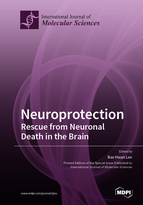Neuroprotection: Rescue from Neuronal Death in the Brain
A special issue of International Journal of Molecular Sciences (ISSN 1422-0067). This special issue belongs to the section "Molecular Neurobiology".
Deadline for manuscript submissions: closed (31 December 2020) | Viewed by 97834
Special Issue Editor
Interests: mechanisms of pain; neural injury; functional recovery; higher order functions of the brain; science of emotion and sensibility
Special Issues, Collections and Topics in MDPI journals
Special Issue Information
Dear Colleagues,
The brain is vulnerable to injury. Following injury in the brain, apoptosis or necrosis may occur easily, leading to various functional disabilities. Neuronal death is associated with a number of neurological disorders including hypoxic ischemia, epileptic seizures, and neurodegenerative diseases.
The brain subjected to injury is regarded to be responsible for the alterations in neurotransmission processes, resulting in functional changes. Oxidative stress produced by reactive oxygen species has been shown to be related to the death of neurons in traumatic injury, stroke, and neurodegenerative diseases. Therefore, scavenging or decreasing free radicals may be crucial for preventing neural tissues from harmful adversities in the brain. Neurotrophic factors, bioactive compounds, dietary nutrients, or cell engineering may ameliorate the pathological processes related to neuronal death or neurodegeneration and appear beneficial for improving neuroprotection. As a result of neuronal death or neuroprotection, the brain undergoes activity-dependent long-lasting changes in synaptic transmission, which is also known as functional plasticity.
Neuroprotection implying the rescue from neuronal death is now becoming one of global health concerns. This Special Issue attempts to explore the recent advances in neuroprotection related to the brain. This Special Issue welcomes original research or review papers demonstrating the mechanisms of neuroprotection against brain injury using in vivo or in vitro models of animals as well as in clinical settings. The issues in a paper should be supported by sufficient data or evidence.
Prof. Bae Hwan Lee
Guest Editor
Manuscript Submission Information
Manuscripts should be submitted online at www.mdpi.com by registering and logging in to this website. Once you are registered, click here to go to the submission form. Manuscripts can be submitted until the deadline. All submissions that pass pre-check are peer-reviewed. Accepted papers will be published continuously in the journal (as soon as accepted) and will be listed together on the special issue website. Research articles, review articles as well as short communications are invited. For planned papers, a title and short abstract (about 100 words) can be sent to the Editorial Office for announcement on this website.
Submitted manuscripts should not have been published previously, nor be under consideration for publication elsewhere (except conference proceedings papers). All manuscripts are thoroughly refereed through a single-blind peer-review process. A guide for authors and other relevant information for submission of manuscripts is available on the Instructions for Authors page. International Journal of Molecular Sciences is an international peer-reviewed open access semimonthly journal published by MDPI.
Please visit the Instructions for Authors page before submitting a manuscript. There is an Article Processing Charge (APC) for publication in this open access journal. For details about the APC please see here. Submitted papers should be well formatted and use good English. Authors may use MDPI's English editing service prior to publication or during author revisions.
Keywords
- Neuroprotection
- Brain injury
- Neuronal death
- Neurodegeneration
- Neurological disorders
- Functional plasticity







